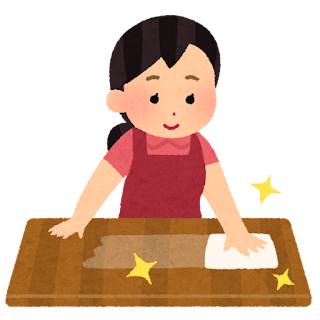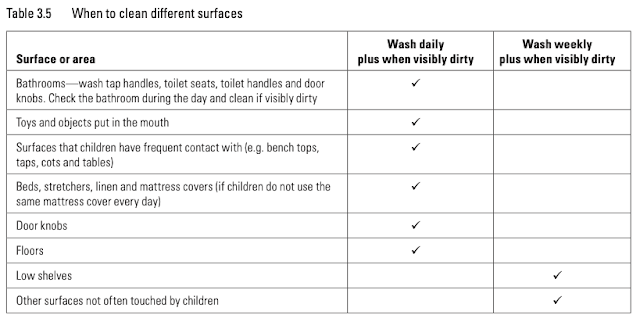Childcare|CHCECE002 #3 - Implement effective hygiene and health practices (part 1)
學習筆記 Note Childcare
CHCECE002
Ensure the health and safety of children
#3 - Implement effective hygiene and health practices
(part 1)
 |
| 來源:いらすとや |
.consistently implement hygiene practices that reflect advice from relevant health authorities
.support children to learn personal hygiene practices
.implement the service health and hygiene policy and procedures consistently
.ensure service cleanliness is consistently maintained
.observe and respond to signs of illness and injury in children
.systematically record and share this information with families
.consistently implement the service policies for the exclusion of ill children
.discuss health and hygiene issues with children
adequate health and hygiene practices and safe practices for handling, preparing and storing food
.NQS 2.1.2
effective illness and injury management and hygiene practices are promoted and implemented
# Housekeeping
.= regular steps taken to keep the service equipment and premises clean and tidy
.ensure health and hygiene at the service includes the daily, weekly cleaning and cleaning that takes place multiple times a day
.essential part to ensure safe and healthy environment
.implement adequate health and hygiene practices
 |
| When to clean different surfaces Source: Staying Healthy 5th Edition |
# Examples of Housekeeping
.keep areas clean, free from bacteria + viruses (tidying, removing dirt, food and dust, cleansing surfaces)
.regular cleaning (bathroom, surfaces, equipment, toys, cots, dolls's clothing)
.daily cleaning (floors, beds, bedding, toys, linen)
.use dishwasher with high temperature to clean
.follow Staying Healthy recommendations
# How to clean toys (from Staying Healthy)
.wash effectively → reduce spread of disease
.wash end of each day (especially younger children rooms)
.wash in warm water and detergent, rinse them well / in a dishwasher (but not at the same time as dishes)
.all toys (include cloth toys and books) can be dried by sunlight
.individual toys may be kept in the child’s cot or bag for the use of that child only
.books - inspect for visible dirt, clean by wiping with a moist cloth with detergent on it, and allowing to dry, keep damp or wet books out of use until they are dry
.start a ‘Toys to wash’ box and place toys in it during the day if you see a child sneeze on a toy or put a toy in their mouth, or if the toy has been used by a child who is unwell
.spilt the toys into two lots and rotated between washing one day and in use the next
.In the nappy change area, have a box of clean toys and a box of toys to be washed. Give a child a clean toy if they need one while being changed. Immediately after the nappy change, place the toy in the ‘Toys to wash’ box.
# How to clean Nappy Change Area (from Staying Healthy)
.after each nappy change, clean thoroughly with detergent and water, rinsing and drying with single-use paper towel
.remove the nappy change surface (waterproof sheet or change mat), wash it with warm water and detergent and dry it, preferably in the sun
# Involved children in cleaning
.children can be involved in learning to clean items by making them as fun activities
.only use mild or neutral soap / detergent
.aware of any child's sensitivity
# Methods for assisting service cleanliness and hygiene
.use floor coverings that are easily cleanable
.good storage space that keeps toys off the floor
.natural and electric lighting
.good ventilation / flow of fresh air
.use flyscreens over windows and doors
.use removable covers on cushions and sofas
.ensure rubbish bins are emptied regularly
.use 'toys to wash' box
# Cleaning agents
.for most cleaning tasks → warm soapy water
.ensure surface is completely dry
.disinfect for areas that are frequently touched, contaminated by body substances
.diluted bleach → use to disinfect blood spills, use according to manufacturer's instructions, make up a new batch each time (bleach loses strength over time)
> NEVER use bleach in a spray bottle
> NEVER use hot water to dilute bleach
> NEVER mix bleach with any other chemicals
> NEVER use bleach (corrosive) on metals other than stainless steel
.other safer cleaning agents: white vinegar, lemon juice, bicarbonate of soda
 |
| When to use disinfectant Source: Staying Healthy 5th Edition |
# Clean Kitchens
.wipe up spills immediately
.keep surfaces clean at all time
.acrylic cutting boards: easy to clean, can be placed in a dishwasher
.use different coloured boards for different types of foods: prevent cross-contamination
.use different coloured cloth for different cleaning area
.regular check and cleaning for fridges, freezers and cupboards
# Hygiene and health in outdoor areas
.large good shade for children to play under
.wear hats, sunglasses and apply sunscreen before going outside into the sun
.outdoor areas should be kept clear of poisonous plants
KidSafe NSW - list of poisonous plants
Poisons Information Centre - phone number: 13 11 26 (24/7, anywhere in Aus)
provide toxicological advice (毒理學建議)on the management of exposure to prescription and non-prescription pharmaceuticals, household and industrial chemicals, plants, animal envenomation(動物毒液), pesticides, other agricultural products(農產品)
.be aware of plants that attract bees or that have pollen that children may be allergic to
.regular check for spiders & snakes
.keep containers / areas clear from water
.cover open water area with child-safe mesh
#Outdoor equipment
.include moveable & fixed item (e.g. climbing frames, balancing beams, cubby houses, seesaws)
.safe, clean, good repair
→ free of splinters(碎片), rust, shape edges
→ check any screws for rust (螺絲生鏽)& ropes for fraying (繩索磨損)
→ check supports are strong & height of equipment meet current recommendations
→ install / place soft-fall impact surfacing below equipment
# SunSmart online learning module
.learning resource
SunSmart online learning module by Cancer Council
Related post 相關 - SunSmart online learning module notes
.sun provide essential vitamin D → help absorption of vitamin C, make strong bones
.too much sun = harmful → sunburn, heatstroke, skin cancers
.damaging UV rays penetrate cloud cover
.middle day → UV levels most intense
.surroundings reflect the sun → harmful
# Ensure sandpit is a safe area
.cover sandpit when not in use
.check for insects and items that could pose dangers
.disinfect
.add coarse salt (粗鹽)to deter (制止/威嚇/阻止)insects



留言
發佈留言